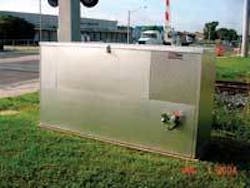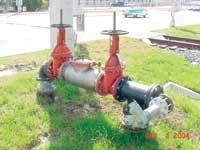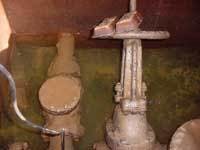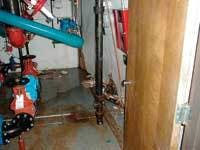Valves: Placement and Protection
Backflow preventers are mechanical devices designed to prevent contaminated water from back siphoning into potable water distribution systems. They’re instrumental in protecting our water supply from both accidental and malicious introduction of toxins into our downstream distribution systems.
Traditionally, these devices have been installed in one of three locations. Those include building equipment rooms, pits and vaults, or outside and aboveground. There are both positive and negative aspects to each placement.
Equipment Rooms
Placing a backflow preventer in an equipment room protects it from vandalism and generally, from environmental conditions. Equipment rooms hide unsightly valves from view. Placing the device in an equipment room, however, takes up valuable floor space; and, in cases where the device “dumps” water (which it’s designed to do under certain conditions), flooding of interior spaces can result. (An 8” backflow preventer can dump up to 1,000 gallons per minute. In one such case, the resulting lawsuit was settled by a $6 million insurance payment.)
Pits and Vaults
Backflow preventers may be placed in pits and vaults in certain situations. When legal - as regulations may vary based on local or state plumbing codes - the pit or vault does protect the instrument from tampering and often, from environmental considerations. Still, most valves must be installed where there’s positive drainage lest a backflow contamination occur if the valve dumps. Any pit (below grade) or vault (whether below or above grade), a concrete or other enclosure that may be open or closed at the bottom - is generally defined as a confined space. As such, entry into the space is governed by OSHA Confined Space Entry Requirements, which are extensive in detail. Adhering to these can be expensive, but following the requirements is necessary as over 350 deaths a year occur in confined space incidents.
Outside & Aboveground
In relatively benign climates such as Florida and Southern California, it’s common to put backflow preventers outside and aboveground. Confined space issues cease to exist and a “dumping” valve usually poses no more serious problems than a wet sidewalk or median. But many people do consider the valves to be unsightly and an unprotected valve is vulnerable to mischief, theft of metal or more serious criminality. In northern climates, freezing conditions preclude placement of an unprotected valve outside and aboveground.
Outdoor Enclosure
A solution to all of the drawbacks of the various placements of backflow devices listed above is the outdoor enclosure. Placing a valve outside in an enclosure frees up valuable equipment room space. If installed, drainage ports prevent water from backing up in the enclosure. And the valve is hidden from sight, minimizing the likelihood of tampering by miscreants.
Where aesthetics are a consideration, in addition to the traditional enclosure, environmentally appropriate enclosures designed as rocks and even tree stumps are available. In northern climates, heat may be added to the enclosure with tested and certified protection for the valve to temperatures of -30°F outside, keeping the temperature in the enclosure at +40°F
To protect the customer that chooses to place their valves in outside enclosures, several reputable manufacturers have subjected their products to testing and certification by the American Society of Sanitary Engineering. Buying an enclosure that bears the ASSE1060 Seal assures the owner of the valve they’re getting the protection sought.
About the Author: Alan Bullen has been national sales manager for Hot Box since 2000. Prior to that, he held management positions in the plumbing industry. Jacksonville, FL-based Hot Box is a division of CDR Systems Corp., of Ormond Beach, FL. Contact [email protected]




